
U.S. Commission on Civil Rights
Funding Federal Civil Rights Enforcement: 2000 2003
April 2002
INTRODUCTION
The Office of Civil Rights Evaluation reviewed data relevant to civil rights enforcement funding for FYs 1994 2003 for:
The U.S. Department of Education (DOEd), Office for Civil Rights (OCR)
The U.S. Department of Justice (DOJ), Civil Rights Division (CRD)
The U.S. Department of Health and Human Services (HHS), Office for Civil Rights (OCR)
The U.S. Equal Employment Opportunity Commission (EEOC)
The U.S. Department of Labor, Office of Federal Contract Compliance Programs (OFCCP)
The U.S. Department of Housing and Urban Development (HUD), Office of Fair Housing and Equal Opportunity (FHEO), which includes the Fair Housing and Assistance Program (FHAP) and Fair Housing Initiatives Program (FHIP)
Since 1957, Congress and the President have greatly expanded the federal civil rights effort through the creation of additional substantive rights and other enforcement agencies. Today, the major statutes and executive orders affecting civil rights enforcement are:
The Equal Pay Act of 1963
The Civil Rights Act of 1964; the Voting Rights Act of 1965
President Johnson's Executive Order 11246 of 1965
The Age Discrimination in Employment Act of 1967
Title VIII of the Civil Rights Act of 1968
Title IX of the Education Amendments of 1972
The Equal Employment Opportunity Act of 1972
The Rehabilitation Act of 1973
The Voting Rights Act Amendments of 1975
The Age Discrimination Act of 1975
President Carter's Reorganization Plan No. 1
Executive orders relating to equal opportunity in 1978 1979
The Voting Rights Amendments of 1982
The Civil Rights for Institutionalized Persons Act of 1986
The Housing and Community Development Act of 1987
The Civil Rights Restoration Act of 1987
The Civil Liberties Act of 1988
The Fair Housing Amendments Act of 1988
The Americans with Disabilities Act of 1990
The Civil Rights Act of 1991
The Voting Rights Language Assistance Act of 1992
SCOPE AND METHODOLOGY
This review augments earlier Commission reports that analyzed the budget requests of the Clinton and Bush administrations from FY 1994 to FY 2002 by presenting the FY 2002 actual appropriations and the FY 2003 President's request. All references to real funding are expressed in constant 1994 dollars. Expression in constant dollars accounts for inflationary trends and more accurately reflects the actual purchasing power of the funds. In previous Commission reports, as well as this one, adjusted values have been referred to as real funding or 're al spending power. The deflators used are the same as those used by OMB in the U.S. Office of Management and Budget, Budget of the United States: Historical Tables, Fiscal Year 2003, Table 2.3, p. 25. The deflators have been used in other analyses performed by the Commission, including its 1995 Funding Federal Civil Rights Enforcement report and its 2001 report Funding Federal Civil Rights Enforcement: 2000 and Beyond.
In its 1995 and 2001 reports, the Commission measured agency workload (pending inventory, complaints processed, compliance reviews, etc.) and staffing levels. Since these measurements were taken recently and the trends were found to be consistent during the period studied, the Commission did not measure workload and staffing levels again. Additionally, through ongoing monitoring, the Commission discovered no sweeping changes during the past year that would have altered workload trends. Unless otherwise indicated, documents produced by the agencies and the Office of Management and Budget (OMB) are the major sources for information in this review.
ANALYSIS
The Commission's 1995 report on funding levels for federal civil rights enforcement concluded that reductions in funding and staff continue to undermine our national enforcement of civil rights. [1] The Commission reviewed civil rights funding again in 2001 and concluded that the nation's civil rights laws remain, in large measure, unfunded mandates. [2] In these reports, the Commission concluded that civil rights laws have significantly affected the workloads of all the agencies studied. The reductions in civil rights agencies budgets occurred at a time when the civil rights enforcement responsibilities of the agencies had grown substantially. The data, which follow, demonstrate that since the 1995 report, the nation's enforcement of civil rights laws continues to be threatened by insufficient funding for federal civil rights agencies.
For FY 2003, after accounting for inflation, the President s request amounts to increases for four of the six enforcement agencies reviewed. The largest increase represented in the presidential requests is for HUD/FHAP, which is 10.9 percent, followed by DOEd/OCR in which the President requested a 9.7 percent increase. The President's largest request for decreased funding is a 14.9 percent reduction for HUD/FHIP (see Summary Table).
For FY 2002, President Bush requested budget increases for all civil rights enforcement offices reviewed except EEOC, FHIP, and OFCCP. However, DOEd was the only agency in FY 2002 in which Congress approved funding commensurate with the President's Request (see Summary Table).
|
Summary Table Civil Rights Enforcement Funding, FYs 2001 2003 (1994 inflation-adjusted dollars) |
||
|
Civil Rights Enforcement Agency |
President's Request |
Congressional Appropriation |
|
FY 2001 2002 Change |
||
|
DOEd/OCR |
3.2 % increase |
3.0 % increase |
|
EEOC |
5.7 % decrease |
0.1 % decrease |
|
OFCCP |
2.3 % decrease |
0.2 % decrease |
|
DOJ/CRD |
1.1 % increase |
7.3 % increase |
|
HHS/OCR |
16.2 % increase |
8.6 % increase |
|
HUD/FHEO |
(Data not available) |
|
|
HUD/FHAP |
6.6 % increase |
13.7 % increase |
|
HUD/FHIP |
22.3 % decrease |
17.3 % decrease |
|
|
FY 2002 2003 Change |
|
|
DOEd/OCR |
9.7 % increase |
|
|
EEOC |
2.2 % increase |
|
|
OFCCP |
0.2 % decrease |
|
|
DOJ/CRD |
1.8 % increase |
|
|
HHS/OCR |
1.5 % decrease |
|
|
HUD/FHEO |
(Data not available) |
|
|
HUD/FHAP |
10.9 % increase |
|
|
HUD/FHIP |
14.9 % decrease |
|
Furthermore:
Since FY 1994, DOEd/OCR s budget, in actual dollars, has increased by 41.2 percent. But after adjusting for inflation, the agency realized only a 20 percent increase in funding. For each fiscal year since 1994, had Congress appropriated exactly what the President requested, including the President's FY 2003 request, DOEd/OCR's budget would have increased by 58.6 percent. After adjusting for inflation, the agency would have received a 31.8 percent increase in its budget.
Between FYs 1994 and 2002, Congressional appropriations for EEOC increased by 34.8 percent. After adjusting for inflation, EEOC's budget has increased by only 14.5 percent in the past nine years. Between FYs 1994 and 2003, had Congress met the President's request, EEOC would have received a budget increase of 37.8 percent in actual dollars. But in real spending power, the increase would have been only 14.6 percent.
Since FY 1994, OFCCP's budget has increased 37.7 percent. But once inflation is taken into account this increase amounts to only 17 percent. Had the President s requests been met between FYs 1994 and 2003, OFCCP would have received an increase of 39.9 percent, which would have resulted in a 16.4 percent increase after adjusting for inflation.
Of the federal agencies reviewed in this report, DOJ/CRD received the largest percentage increase in its budget over the past nine years. Between FYs 1994 and 2002, the Division's budget grew by 67.9 percent. After adjusting for inflation, the budget grew by 42.5 percent. Between FYs 1994 and 2003, even if Congress had approved funding based on the President's request, DOJ/CRD's budget would have grown by 78.1 percent in actual dollars and 48.1 percent in real dollars.
Between FYs 1994 and 2002, Congressional appropriations for HHS/OCR increased by 40.1 percent in actual dollars, although this resulted in only an 18.9 percent increase after adjusting for inflation. Had the President's requests been met between FYs 1994 and 2003, HHS/OCR's budget would have increased by 45.4 percent in actual dollars and 20.7 percent in real dollars.
Of the two HUD programs reviewed in this report, FHAP has received the largest increase in funding in the past nine years. Between FYs 1994 and 2002, FHAP's budget increased by 467.6 percent. In terms of real spending power, the budget has grown by 384.4 percent. Had the President's request been met each fiscal year between 1994 and 2003, FHAP's budget would have increased by 475.3 percent in actual dollars and 380.0 percent in real dollars.
Unlike FHAP, between FYs 1994 and 2002, FHIP's budget decreased by 1.1 percent in actual dollars and 16.1 percent in real dollars. In terms of spending power, FHIP's budget for FY 2002 is less than it was in FY 1994. Between FYs 1996 and 2002, Congress did not grant FHIP the amount that the President requested. Had Congress granted the President's request between FYs 1994 and 2003, FHIP's budget would have increased by 18.3 percent in actual dollars, but in terms of real spending power, the appropriation would have resulted in a 1.8 percent decrease in funding.
Office for Civil Rights, U.S. Department of Education
Although President Clinton requested increases in OCR's budget for FY 1995 and FY 1996 (compared with the FY 1994 request and appropriation), the budget requests for FY 1997 and FY 1998 were lower than the FY 1996 request in both actual and constant dollars (see tables 1 and 2). However, between FY 1994 and FY 1997 Congressional appropriations for OCR gradually decreased, from $56.6 million to $54.9 million (see table 1). The next year, Congress met the President's request of $61.5 million, which increased OCR's budget by 12 percent over its FY 1997 appropriation.
For FY 1999, the President requested 10.6 percent more funding than was appropriated for OCR in FY 1998. Although Congress did not grant the President's request, OCR s appropriation of $66 million for FY 1999 was 7.3 percent higher than in FY 1998 (see table 1). In real terms, the appropriation represented a 5.6 percent increase between FY 1998 and FY 1999 (see table 2). In FY 2000, OCR received another increase from Congress, raising its budget to $71.2 million. However, in real spending power the FY 2000 increase was only 5 percent above the FY 1999 appropriation (see figure 1).
Overall, between FY 1994 and FY 2002, despite the decline in appropriations between FY 1994 and FY 1997, OCR's budget increased by $23.3 million a 41.2 percent increase. In real spending power, however, the budget increased by only 20 percent.
For FY 2003, President Bush is requesting $89.7 million in funding, which is 12.1 percent more than was requested in FY 2002 (see table 1). In real spending power, the President's request would provide only $74.6 million in funding, which represents a 10 percent increase over what was requested in FY 2002 (see figure 1). The President's FY 2003 request is level with the FY 2002 Congressional appropriation. In real spending power, if the President's FY 2003 funding is granted, it will be the largest increase that OCR has received since FY 1998.
|
Table 1 Department of Education/OCR Funding History (in millions of actual dollars) |
||
|
|
|
|
|
Fiscal Year |
Congressional Appropriation |
President s Request |
|
1994 |
56.6 |
56.6 |
|
1995 |
58.2 |
61.5 |
|
1996 |
55.3 |
62.8 |
|
1997 |
54.9 |
60.0 |
|
1998 |
61.5 |
61.5 |
|
1999 |
66.0 |
68.0 |
|
2000 |
71.2 |
73.3 |
|
2001 |
76.0 |
76.0 |
|
2002 |
79.9* |
80.0 |
|
2003 |
|
89.7** |
|
|
||
|
* The 2002
Congressional appropriation figure was provided by the Office for Civil
Rights. |
||
|
Table
2 Department of Education/OCR Funding History |
||
|
|
|
|
|
Fiscal Year |
Congressional Appropriation |
President s Request |
|
1994 |
56.6 |
56.6 |
|
1995 |
56.9 |
60.0 |
|
1996 |
52.8 |
59.9 |
|
1997 |
51.3 |
56.1 |
|
1998 |
56.8 |
56.8 |
|
1999 |
60.0 |
61.8 |
|
2000 |
63.0 |
64.9 |
|
2001 |
65.9 |
65.9 |
|
2002 |
67.9 |
68.0 |
|
2003 |
|
74.6 |

U.S. Equal Employment Opportunity Commission
As established in earlier Commission reports, the passage of new legislation and the expansion of existing civil rights statutes over the past decade have increased EEOC's responsibilities and, consequently, its workload. However, the agency's funding has not increased in accordance with its rising workload. Funding requests decreased between FY 1996 and FY 1998 (see table 3). In fact, after adjusting for inflation, the FY 1998 request was lower than the FY 1994 request by 3 percent (see table 4 and figure 2). In addition, the FY 1998 request was lower, in actual dollars, than the FY 1997 request by more than $20 million. Between FYs 1999 and 2002, the President requested increased funding for EEOC (see table 3).
In the past nine years, Congress met the President's request only twice (see table 3). In FY 1999, the Congressional appropriation matched the request of $279 million. However, in FY 2000 and FY 2001 Congress again funded the agency by an amount substantially lower than that requested. The FY 2000 appropriation was 10 percent below the President's request for that year, and the FY 2001 appropriation was 5.6 percent less than the President requested. Further, in real terms, the FY 2000 appropriation represented a 1.9 percent reduction in spending power. Congressional appropriation was matched for the second time in FY 2002, when EEOC received $310 million in funding.
For FY 2003, President Bush is requesting $323.5 million in funding for EEOC (see table 3). In real spending power, this amount is equal to only $269.0 million (see table 4 and figure 2).
|
Table 3 EEOC Funding History (in millions of actual dollars) |
||
|
Fiscal Year |
Congressional Appropriation |
President s Request |
|
1994 |
230.0 |
234.8 |
|
1995 |
233.0 |
245.7 |
|
1996 |
233.0 |
268.0 |
|
1997 |
239.7 |
268.0 |
|
1998 |
242.0 |
246.0 |
|
1999 |
279.0 |
279.0 |
|
2000 |
280.9 |
312.0 |
|
2001 |
304.0 |
322.0 |
|
2002 |
310.0* |
310.0 |
|
2003 |
|
323.5** |
|
* The 2002
Congressional appropriation figure was provided by the Budget Division. |
||
|
Table 4 EEOC Funding History (in millions of constant 1994 dollars) |
||
|
Fiscal Year |
Congressional Appropriation |
President s Request |
|
1994 |
230.0 |
234.8 |
|
1995 |
227.6 |
240.0 |
|
1996 |
222.4 |
255.8 |
|
1997 |
224.1 |
250.6 |
|
1998 |
223.4 |
227.1 |
|
1999 |
253.5 |
253.5 |
|
2000 |
248.7 |
276.2 |
|
2001 |
263.5 |
279.1 |
|
2002 |
263.3 |
263.3 |
|
2003 |
|
269.0 |
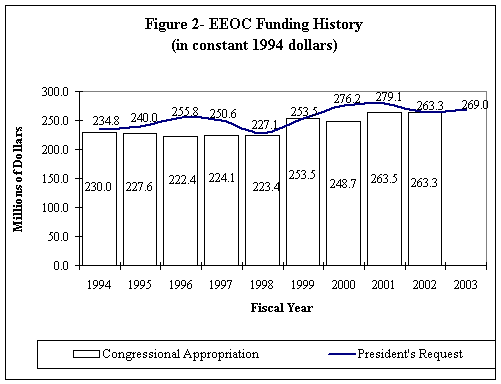
Office of Federal Contract Compliance Programs, U.S. Department of Labor
Although OFCCP's budget requests have increased almost 38 percent in actual dollars since FY 1994, Congress has consistently appropriated an amount lower than was requested (see table 5). Although OFCCP's budget has increased 17 percent in real terms since FY 1994, this increase has not been consistent. Between FY 1994 and FY 1997, Congressional appropriations decreased by 2 percent in real terms (see table 6).
While OFCCP has experienced an increase in funding since FY 1997, the agency's budget may not keep up with inflation in the future. For example, the FY 1999 request was lower than the FY 1998 request in both actual and real dollars (see table 5 and figure 3). Further, in both actual and real dollars, the President's FY 2001 request was below the FY 2000 request. In FY 2002, in both actual and real dollars, the Congressional appropriation exceeded the President's request (see tables 5 and 6 and figure 3).
For FY 2003, President Bush is requesting only 2 percent more in funding than was requested in the previous year. For FY 2003, President Bush is requesting $77.5 million, but after adjusting for inflation this funding amount is equal to only $64.5 million (see table 6 and figure 3). If this request is granted, OFCCP will receive a decrease in funding of less than 1 percent.
|
Table 5 OFCCP Funding History (in millions of actual dollars) |
||
|
Fiscal Year |
Congressional Appropriation |
President s Request |
|
1994 |
56.4 |
55.4 |
|
1995 |
58.9 |
59.9 |
|
1996 |
56.9 |
63.8 |
|
1997 |
59.1 |
65.5 |
|
1998 |
62.3 |
68.7 |
|
1999 |
65.5 |
67.8 |
|
2000 |
73.3 |
76.4 |
|
2001 |
76.0 |
76.3 |
|
2002 |
77.7* |
76.0 |
|
2003 |
|
77.5** |
|
|
||
|
*The 2002 Congressional appropriation
figure was provided by the
Budget Section. |
||
|
Table 6 OFCCP Funding History (in millions of constant 1994 dollars) |
||
|
|
|
|
|
Fiscal Year |
Congressional Appropriation |
President s Request |
|
1994 |
56.4 |
55.4 |
|
1995 |
57.6 |
58.5 |
|
1996 |
54.3 |
60.9 |
|
1997 |
55.2 |
61.2 |
|
1998 |
57.5 |
63.5 |
|
1999 |
59.5 |
61.6 |
|
2000 |
64.9 |
67.7 |
|
2001 |
65.9 |
66.1 |
|
2002 |
66.0 |
64.6 |
|
2003 |
|
64.5 |
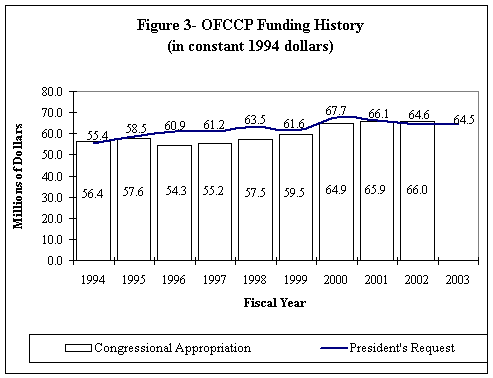
Civil Rights Division, U.S. Department of Justice
Between FY 1994 and FY 1998, CRD budget requests fluctuated from year to year while Congressional appropriations for the Division remained relatively stable (see table 7). In addition, Congressional appropriations remained below the President's budget request between FY 1995 and FY 1998.
Although $71.9 million was requested for CRD in FY 1995, Congress approved only $62.2 million (see table 7). The amount represented a 4 percent increase over the FY 1994 appropriation. In FY 1996, Congress again increased CRD's budget by $2 million in actual dollars. However, in terms of real spending power, CRD's budget remained level (see table 8). In real dollars, the budget provided by Congress in FY 1997 was again lower than the previous year s, and 2.3 percent lower than the Division's FY 1994 appropriation. Further, the FY 1998 budget appropriation equaled the FY 1994 appropriation in real dollars (see figure 4). This relatively flat pattern of appropriations prior to FY 1999 is alarming considering that the Division s budget appropriations had increased substantially between FY 1981 and FY 1993.[3]
Between FY 1999 and FY 2001, the President's requests for CRD funding have increased by more than $10 million each year. Nonetheless, funding for CRD is insufficient. In July 2000, then-acting Assistant Attorney General Bill Lann Lee stated that the FY 2000 budget increase has not made up for the fact that for many years, the Civil Rights Division has basically been running on empty.
In both real and actual dollars, CRD's FY 1999 budget was considerably higher than the budget appropriations between FY 1994 and FY 1998 (see tables 7 and 8). However, more than $8 million of the FY 1999 budget was reprogrammed for the administration of Y2K modifications and Japanese redress payments, and thus, did not go toward Division civil rights enforcement. The President's request for FY 2002 was only $4 million more than was requested in FY 2001 (see table 7). The FY 2002 request was the highest request made during the entire period between FY 1994 and FY 2002.
For FY 2003, President Bush is requesting $105.1 million in funding for CRD. If granted, the requested funding would result in a 4 percent increase from the previous year's appropriation (see table 7). In real dollars, the President's budget request would amount to only $87.4 million (see table 8 and figure 4).
|
Table 7 Department of Justice/CRD Funding History (in millions of actual dollars) |
||
|
|
|
|
|
Fiscal Year |
Congressional Appropriation |
President s Request |
|
1994 |
60.0 |
59.0 |
|
1995 |
62.6 |
71.9 |
|
1996 |
64.5 |
65.3 |
|
1997 |
62.4 |
69.6 |
|
1998 |
64.7 |
67.5 |
|
1999 |
77.3 |
71.6 |
|
2000 |
82.2 |
82.2 |
|
2001 |
92.0 |
97.9 |
|
2002 |
100.6 |
101.0* |
|
2003 |
|
105.1* |
|
* Figures for 2002 and 2003 were provided by the Civil Rights Division. |
||
|
Table
8 Department of Justice/CRD Funding History |
||
|
Fiscal Year |
Congressional Appropriation |
President's Request |
|
1994 |
60.0 |
59.0 |
|
1995 |
61.1 |
70.2 |
|
1996 |
61.6 |
62.3 |
|
1997 |
58.4 |
65.1 |
|
1998 |
59.7 |
62.3 |
|
1999 |
70.2 |
65.1 |
|
2000 |
72.7 |
72.8 |
|
2001 |
79.7 |
84.9 |
|
2002 |
85.5 |
85.8 |
|
2003 |
|
87.4 |
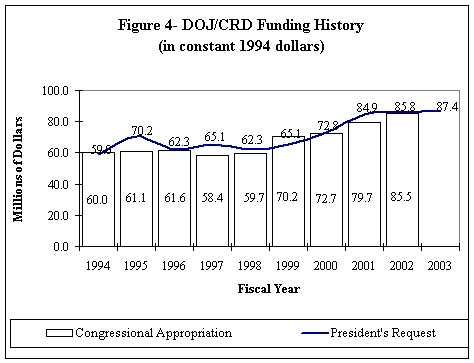
Office for Civil Rights, U.S. Department of Health and Human Services
In actual dollars, OCR's budget remained relatively stable throughout the last half of the 1990s. However, in terms of real spending power, both the budget requests and appropriations for OCR decreased during this time (see figure 5). From FY 1996 to FY 2000, the budget requests for the Office for Civil Rights, in actual dollars, have consistently remained lower than the FY 1994 request (see table 9). Correspondingly, the real spending power of the FY 2000 budget request for OCR was nearly 12 percent below the FY 1994 figure (see table 10). In addition, Congressional appropriations from FY 1995 to FY 1999 have been consistently lower in actual dollars than the FY 1994 appropriation (see table 9).
When looking at the past two decades and accounting for inflation, the FY 2000 budget is more than 60 percent below the real spending power of the FY 1981 budget. The Commission noted in 1999:
OCR operates under severe budgetary constraints . . . OCR's responsibilities and workload have increased over the past several years, yet its funding and staffing have decreased. OCR's budget has fluctuated around $20 million since 1981, and has not kept up with inflation.[4]
For FY 2003, President Bush is requesting level funding for OCR (see table 9). In actual dollars, the President is requesting $32.3 million. But in real terms, this request, if granted, will provide OCR with a budget of only $26.8 million, resulting in less than a 2 percent increase from the previous year's appropriation (see table 10 and figure 5).
|
Table
9 Department of Health and Human Services/OCR Funding History |
||
|
Fiscal Year |
Congressional Appropriation |
President's Request |
|
1994 |
22.2 |
22.2 |
|
1995 |
22.1 |
21.9 |
|
1996 |
21.2 |
21.3 |
|
1997 |
19.5 |
21.8 |
|
1998 |
19.7 |
20.5 |
|
1999 |
20.6 |
20.7 |
|
2000 |
22.1 |
22.2 |
|
2001 |
28.0 |
27.0 |
|
2002 |
31.1* |
32.0 |
|
2003 |
|
32.3** |
|
*
The 2002 Congressional appropriation figure was provided by the Office for
Civil Rights. |
||
|
Table 10 Department of Health and Human Services/OCR Funding History (in millions of constant 1994 dollars) |
||
|
Fiscal Year |
Congressional Appropriation |
President's Request |
|
1994 |
22.4 |
22.2 |
|
1995 |
21.6 |
21.4 |
|
1996 |
20.2 |
20.4 |
|
1997 |
18.2 |
20.4 |
|
1998 |
18.2 |
19.0 |
|
1999 |
18.7 |
18.8 |
|
2000 |
19.6 |
19.6 |
|
2001 |
24.3 |
23.4 |
|
2002 |
26.4 |
27.2 |
|
2003 |
|
26.8 |
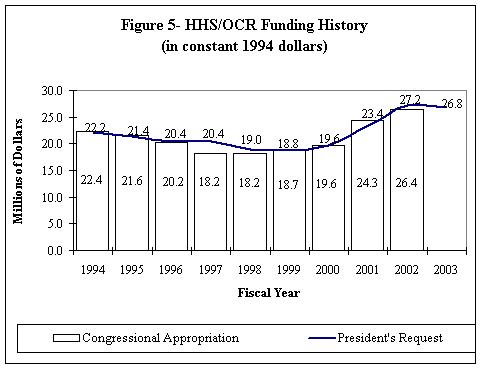
U.S. Department of Housing and Urban Development Office of Fair Housing and Equal Opportunity (FHEO), Fair Housing Assistance Program (FHAP), and Fair Housing Initiatives Program (FHIP)
FHEO
Overall requested funding for FHEO fell in actual dollars between FY 1994 and FY 2000 (see table 11). In terms of real spending power, the amount of funding requested by the President for FHEO decreased 12 percent during this period (see table 12). Between FY 2000 and FY 2001, Congressional appropriations in both actual and real dollars increased by 8.3 percent and 5.9 percent, respectively. In FY 2001, FHEO received $51.4 million in funding (see table 11), but in real terms the amount was much lower, $44.5 million (see table 12 and figure 6).
Between FY 1995 and FY 1998, a series of program adjustments and buyouts adversely affected funding levels for FHEO. As a result, during this period FHEO's budget fell by nearly $4.6 million in actual dollars and $6.9 million in real dollars (see tables 11 and 12). In FY 1999, the requested and appropriated budgets for FHEO increased slightly, compared with the previous year (see figure 6). However, the FY 2000 appropriation was lower than the FY 1999 appropriation in both actual and real terms.
|
Table 11 Department of Housing and Urban Development/Fair Housing and Equal Opportunity (FHEO) Funding History (in millions of actual dollars) |
||
|
Fiscal Year |
Congressional Appropriation |
President's Request |
|
1994 |
49.4 |
51.1 |
|
1995 |
50.1 |
52.2 |
|
1996 |
45.5 |
48.8 |
|
1997 |
46.3 |
49.5 |
|
1998 |
45.5 |
48.7 |
|
1999 |
47.6 |
49.9 |
|
2000 |
47.5 |
50.8 |
|
2001 |
51.4 |
* |
|
2002 |
|
** |
|
2003 |
|
** |
|
|
|
|
|
*The 2001
Congressional figure was provided by the Budget Office. |
||
|
Table 12 Department of Housing and Urban Development/Fair Housing and Equal Opportunity (FHEO) Funding History (in millions of constant 1994 dollars) |
||
|
Fiscal Year |
Congressional Appropriation |
President's Request |
|
1994 |
49.4 |
51.1 |
|
1995 |
48.9 |
51.0 |
|
1996 |
43.4 |
46.6 |
|
1997 |
43.2 |
46.3 |
|
1998 |
42.0 |
45.0 |
|
1999 |
43.2 |
45.3 |
|
2000 |
42.0 |
45.0 |
|
2001 |
44.5 |
|
|
2002 |
|
|
|
2003 |
|
|
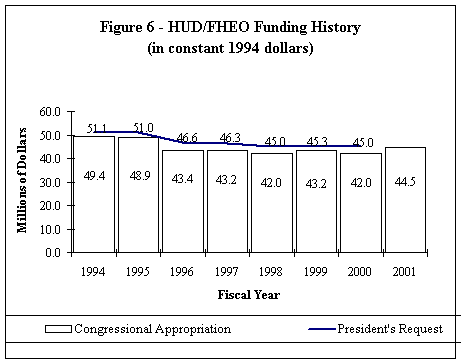
FHAP
In contrast to FHEO, in both actual and real dollars, the budget for FHAP increased between FY 1994 and FY 1997 (see tables 13 and 14). In FY 1994, FHAP received its requested amount of $4.5 (see table 13). Between FY 1994 and FY 1999, the FHAP budget appropriation more than doubled in real dollars (see table 14 and figure 7).
For FY 2003, President Bush has requested $26.0 million for FHAP (see table 13). This amount is significantly higher than the $22.9 million that was requested in FY 2002. In terms of real spending power, if the President s requested is granted, FHAP will receive funding that is level with the FY 2002 Congressional appropriation (see figure 7).
|
Table 13 Department of Housing and Urban Development/Fair Housing Assistance Program (FHAP) Funding History (in millions of actual dollars) |
||
|
Fiscal Year |
Congressional Appropriation |
President's Request |
|
1994 |
4.5 |
4.5 |
|
1995 |
7.4 |
7.4 |
|
1996 |
13.0 |
15.0 |
|
1997 |
15.0 |
15.0 |
|
1998 |
15.0 |
15.0 |
|
1999 |
13.0 |
23.0 |
|
2000 |
20.0 |
20.0 |
|
2001 |
22.0 |
21.0 |
|
2002 |
25.6 |
23.0* |
|
2003 |
|
26.0** |
|
|
|
|
|
*The
figures for 2002 were provided by the Budget Division. |
||
|
Table 14 Department of Housing and Urban Development/ Fair Housing Assistance Program (FHAP) Funding History (in millions of constant 1994 dollars) |
||
|
Fiscal Year |
Congressional Appropriation |
President's Request |
|
1994 |
4.5 |
4.5 |
|
1995 |
7.2 |
7.2 |
|
1996 |
12.4 |
14.3 |
|
1997 |
14.0 |
14.0 |
|
1998 |
13.8 |
13.8 |
|
1999 |
11.8 |
20.9 |
|
2000 |
17.7 |
17.7 |
|
2001 |
19.1 |
18.2 |
|
2002 |
21.8 |
19.5 |
|
2003 |
|
21.6 |
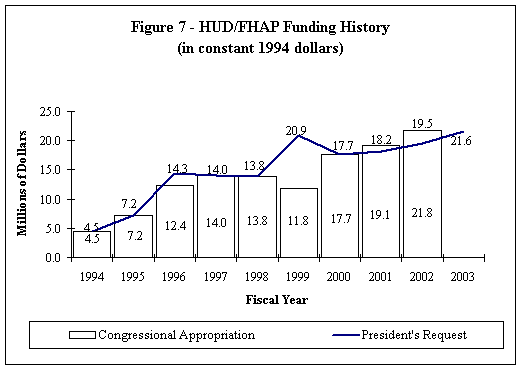
FHIP
In contrast to FHAP, FHIP has experienced a roller coaster of funding since FY 1994. Its Congressional appropriation in actual dollars has fluctuated between $26 million and $15 million (see table 15). In addition, its appropriated funds fell far short of its requested funding in FYs 1996, 1998 and 1999.
For FY 2003, President Bush is requesting level funding at $20.0 million (see table 15). But in real dollars, the requested funding, if approved, would only be worth $16.6 million (see table 16 and figure 8). This level of funding would return FHIP to what its FY 1996 budget was worth (see figure 8).
|
Table 15 Department of Housing and Urban Development/Fair Housing Initiative Program (FHIP) Funding History (in millions of actual dollars) |
||
|
Fiscal Year |
Congressional Appropriation |
President's Request |
|
1994 |
20.5 |
16.9 |
|
1995 |
26.0 |
23.0 |
|
1996 |
17.0 |
30.0 |
|
1997 |
15.0 |
17.0 |
|
1998 |
15.0 |
24.0 |
|
1999 |
22.0 |
29.0 |
|
2000 |
24.0 |
27.0 |
|
2001 |
24.0 |
29.0 |
|
2002 |
20.3 |
22.9* |
|
2003 |
|
20.0** |
|
* The figures for
2002 were provided by the Budget Division. |
||
|
Table 16 Department of Housing and Urban Development/Fair Housing Initiative Program (FHIP) Funding History (in millions of constant 1994 dollars) |
||
|
Fiscal Year |
Congressional Appropriation |
President's Request |
|
1994 |
20.5 |
16.9 |
|
1995 |
25.4 |
22.5 |
|
1996 |
16.2 |
28.6 |
|
1997 |
14.0 |
15.9 |
|
1998 |
13.8 |
22.2 |
|
1999 |
20.0 |
26.4 |
|
2000 |
21.2 |
23.9 |
|
2001 |
20.8 |
25.1 |
|
2002 |
17.2 |
19.5 |
|
2003 |
|
16.6 |
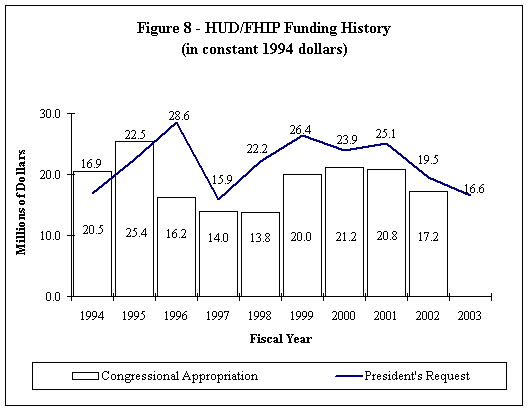
CONCLUSION
This review updates and presents the President's requests and Congressional appropriations of six principal civil rights agencies since FY 1994. Overcoming years of neglect requires significant commitment from Congress and the President. After adjusting for inflation, the budget trend shows that none of the civil rights offices has received continuous increases in funding during the past nine years. Since FY 1999, the budgets of DOEd/OCR and DOJ/CRD have been increasing after fluctuating for numerous years. Since FY 2000, HHS/OCR s budget has increased after continuously decreasing for numerous years. FHIP s budget has been decreasing since FY 2000. Similarly, EEOC s budget has taken a downward turn after peaking in FY 2001. FHEO's budget has remained flat since decreasing in the early 1990s. This has occurred without commensurate reduction in the agencies civil rights authority.
As in earlier reports, the Commission concludes that inadequate funding endures in each of these agencies, thus hindering them from sufficiently exercising their civil rights enforcement authority. As the country strives to ensure the physical safety and security of its citizens during these uncertain times, it must not neglect the responsibility to make certain that its citizens civil rights are protected.
[1] U.S. Commission on Civil
Rights (USCCR), Funding Federal Civil Rights Enforcement, June 1995,
p. 4 (hereafter cited as USCCR, 1995 Budget Report).
[2] U.S. Commission on Civil
Rights (USCCR), Funding Federal Civil Rights Enforcement: 2000 and Beyond,
February 2001, p. 59 (hereafter cited as USCCR, 2001 Budget Report).
[3] USCCR, 1995 Budget Report,
p. 26.
[4] USCCR, The Health Care Challenge: Acknowledging Disparity, Confronting Discrimination, and Ensuring Equality, September 1999, pp. 41 42.